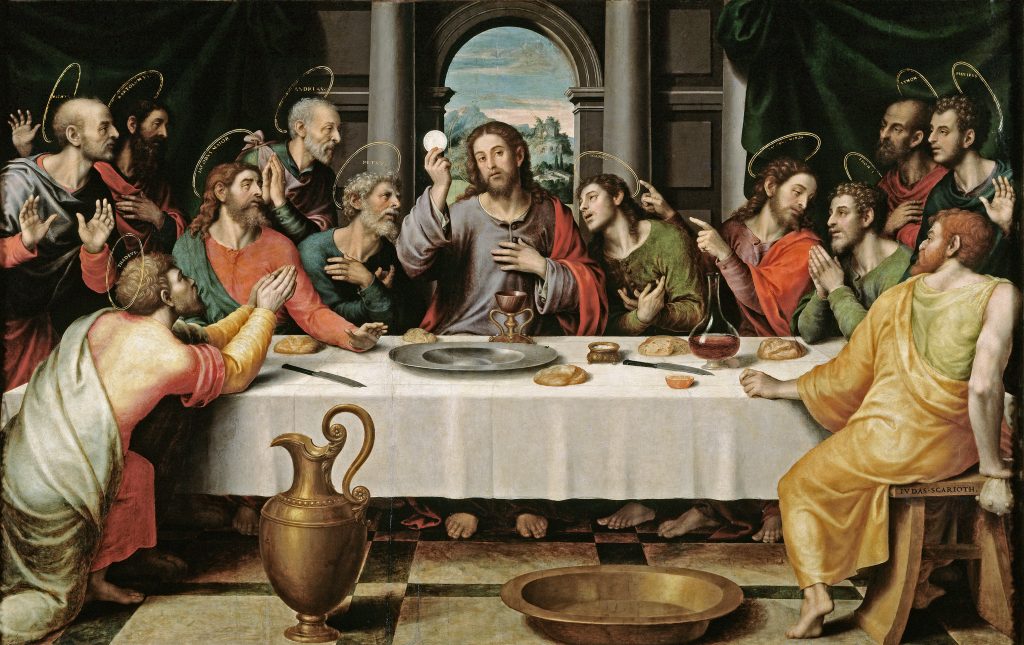
Lesson Objectives
- To learn the "big-picture" overview of the Bible - the story that the Bible tells.
- To understand the concept of "covenant" and its importance for reading and interpreting the Bible.
- To learn in general detail the six major covenants in the Bible.
III. An Introduction to the Covenants of the Bible
A. The Number of the Biblical Covenants
Following St. Irenaeus, we're now ready to look at the number of covenants that God makes in the Bible and the special character of each. God makes six major covenants in the Bible, with:
Adam and Eve (Genesis 1:26-2:3)
Noah and his family (Genesis 9:8-17)
Abraham and his descendants (Genesis 12:1-3; 17:1-14; 22:16-18)
Moses and the Israelites (Exodus 19:5-6; 3:4-10; 6:7)
David and the Kingdom of Israel (2 Samuel 7:8-19)
Jesus and the Church (Matthew 26:28; 16:17-19)
It's important to know these covenants well - what God promises and what is required of those who enter into the covenants.
B. The Character of the Biblical Covenants
Now we'll highlight some of the special characteristics of each of these covenants. As we move through this course we'll be studying each of the covenants in greater detail. For each of these covenants, try to learn and remember the five special features:
the covenant mediator (the person God makes the covenant with) and his covenant role(whom the mediator represents);
the blessings promises in the covenant;
the conditions (or curses) of the covenant;
the "sign" by which the covenant will be celebrated and remembered.
the "form" that God's family has as a result of the covenant.
The Covenant with Adam (Genesis 1:26-2:3)
The word "covenant" isn't used, but as we'll see in detail in our next lesson, the story of Adam and Eve is told in "covenantal" language. Adam is the covenant mediator in his roleas husband. God promises blessings - that their union will be fruitful and their offspring will fill the earth and rule over it. God establishes a sign by which the covenant will be remembered and celebrated - the Sabbath, the seventh day of rest.
And God imposes one condition that they must keep to fulfill their obligation under the covenant - that they not eat from the Tree of the Knowledge of Good and Evil. And God attaches a curse for disobedience - that they will surely die. By this covenant, God's family assumes the form of the marriage bond between husband and wife.
The Covenant with Noah (Genesis 9:8-17)
The word "covenant" is used in the case of Noah, as God promises never again to destroy the world by flood. The covenant is made with all humanity, through the mediator, Noah, in his role as the father of his family.
The covenant includes blessings to Noah and his family (that they will be fruitful and fill the earth) and conditions that must be obeyed (not to drink the blood of any animals, not to shed human blood). The sign of the covenant is the rainbow in the sky. By this covenant, God's people assumes the form of a domestic household, an extended family.
The Covenant with Abraham (Genesis 12:1-3; 17:1-14; 22:16-18)
God swears to give Abraham a great land and to bless his descendants, who will become a great nation. God makes the covenant with the mediator Abraham in his representative roleas chieftain. God promises the blessings of land and great nationhood for his descendants, and through them to bless all the nations of the earth.
The sign of the covenant is the mark of circumcision. Circumcision is also the condition that Abraham and his descendants must obey in order to keep the covenant. By this covenant, God's family is takes a "tribal" form.
The Covenant with Moses (Exodus 19:5-6; 3:4-10; 6:7)
By this covenant, made with the mediator Moses in his representative role as the judge and liberator of Israel, God swears to be Israel's God and Israel swears to worship no other but the Lord God alone. The blessings promised are that they will be God's precious and chosen people.
The conditions of the covenant are that they must keep God's Law and commandments.
The covenant sign is the Passover, which each year commemorates Israel's birth as a nation. By this covenant, God's family assumes the form of a "holy nation, a kingdom of priests."
The Covenant with David (2 Samuel 7:8-19)
God promises to establish the mediator David's "house" or kingdom forever, through David's heir, who will also build a temple to God's name. To David in his role as king, God promises to make David's son His son, to punish him if he does wrong but never take away his royal throne.
"Your house and you kingdom shall endure forever" and through the blessings of this kingdom God promises to give wisdom to all the nations. The sign of the covenant will be the throne and Temple to be built by David's son, Solomon. By this covenant, God's family grows to take the form of a royal empire, a national kingdom.
The New Covenant of Jesus (Matthew 26:28; 16:17-19)
The sixth and final covenant made by the mediator Jesus, who by His Cross and Resurrection assumes the role of royal high priest and fulfills all the promises God made in the previous covenants.
The prophets, especially Isaiah and Jeremiah, had taught Israel to hope for a Messiah who would bring "a new covenant," through which God's law would be written on men's and women's hearts (see Jeremiah 31:31-34; Hebrews 8:8-12).
The conditions of the covenant are that men and women believe in Jesus, be baptized, eat and drink His flesh and blood in the Eucharist, and live by all that He taught. The Eucharist is the sign of the New Covenant. By this covenant, God establishes His family in its finalform as a universal (katholicos or 'catholic' in Greek) worldwide kingdom, which Jesus calls His Church.
Other Lessons
- Lesson Two: From Sabbath to Flood
- To read Genesis 1-12 with understanding.
- To learn the meaning of the first two covenants of salvation history - the Sabbath, and the covenant made with Noah.
- To begin to understand the "patterns" of biblical history.
- Lesson Three: Our Father, Abraham
- To read Genesis 12-50 with understanding.
- To understand God’s covenant with Abraham and to see how that covenant is fulfilled in the New Covenant of Jesus Christ.
- To appreciate key figures and elements in the Abraham story - Melchizedek, circumcision, the sacrifice of Isaac - as they are interpreted in the Church’s tradition.
- Lesson Four: The First-Born Son of God
- To read the Books of Exodus, Leviticus, Numbers, and Deuteronomy with understanding.
- To understand God’s covenant with Israel at Sinai and to see how this covenant looks forward to and is fulfilled in the New Covenant of Jesus Christ.
- To appreciate the key figures and events - Moses, the Passover, and the vocation of Israel as “a kingdom of priests” - as they are interpreted in the Church’s tradition.
- Lesson Five: A Throne For All Generations
- To finish reading the Old Testament (from Joshua to Malachi) and to read with understanding.
- To understand the broad outlines of the history of Israel in light of God’s covenant with Abraham.
- To appreciate the crucial importance of God’s everlasting covenant with David.
- Lesson Six: The New and Everlasting Covenant
- To read the New Testament with understanding.
- To understand how the New Testament depicts Jesus as the fulfillment of the covenants of the Old Testament.
- To appreciate, especially, the importance of God’s everlasting covenant with David for understanding the mission of Jesus and the Church as it is presented in the New Testament.

